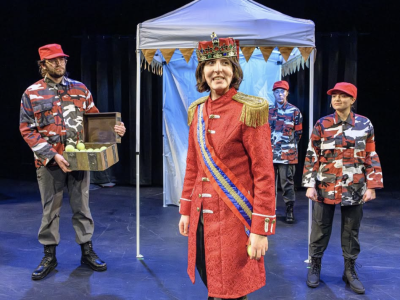[caption id="" align="aligncenter" width="376"]

Margaret Roper[/caption] Margaret More Roper: Scholar and Daughter by Adam White, dramaturg Thomas More was a family man; he was married twice and had four children with his first wife, Jane Colt. After being married for six years, Jane Colt More died, leaving More with four children: Margaret, Elizabeth, Cecily and John. However, More quickly remarried to the widow Dame Alice Middleton, marrying her within a month of his wife’s death. While many of his friends resisted the rapid nature of the arrangement, More went through with it. Thomas and Alice More would raise the four children Thomas More had with Jane, as well as Alice’s daughter from her previous marriage and a foster daughter. Certainly, More valued his family and the welfare of his children. More also valued the power of education. He insisted that his daughters be educated through rigorous schooling, and this was unusual in 16th-century England, as society at large believed women unfit for scholarly pursuits. Despite cultural and institutional norms, Margaret More, the eldest of the More children (and More’s favorite, some would argue), would grow to become one of the most educated people in all of England, a woman of great scholarly knowledge. Margaret More Roper was tutored at home and became well-known for her studies, particularly for her adeptness in Greek and Latin. Her skill in writing and speaking Latin would impress the clergy of England. This specialty is reflected in a scene in Bolt’s A Man for All Seasons where Margaret and King Henry VIII engage in a bit of Latin language sparring. She would also become the first woman who was not of royal birth to publish a translated book. In October 1524, Roper published an English translation of a book called ‘Precatio dominica’ written by Thomas More’s good friend Erasmus. This book was based on the Lord’s Prayer. Instead of translating the book directly from Latin to English, Roper would use her extensive knowledge of both languages to construct the themes and the meanings Erasmus had written in to the treatise with her own words. [caption id="" align="aligncenter" width="291"]

Erasmus, Dutch humanist and good friend to Thomas More[/caption] It was Margaret who would visit the imprisoned Thomas More the most often. They were very close, writing letters to one another regularly the duration of their relationship. It was in a letter to Margaret that Thomas More confided, “I do nobody harm, I say none harm, I thinke none harm, but wish everybody good. And if this be not enough to keep a man alive, in good faith I long not to live.” We have good reason to believe that Margaret More Roper very well understood what would be her father’s fate. After Thomas More’s execution, Margaret More Roper and her husband William Roper would continue to carry on his legacy in their own ways. William Roper would write the first biography of Thomas More, a glowing and gracious document that would influence our understanding of More’s personality for hundreds of years to come. Margaret More Roper actually kept her father’s head after his beheading, pickling it to preserve it from decay. While many of us may find that historical tidbit a tad macabre, I would like to believe that Margaret More Roper had deep admiration for her father; perhaps it was out of this feeling she kept his head. Please stay tuned to the 4th Wall Dramaturgy Blog to catch clips of my interview with Mallory Gee, the actress who will portray Margaret More Roper in BYU’s A Man for All Seasons. Bibliography: Abernathy, Susan. "Margaret Roper, Daughter of Sir Thomas More." Early Modern England. N.p., n.d. Web. 04 Feb. 2014. Duerden, Richard. "A Man for All Seasons." Telephone interview. 31 Jan. 2014. "Margaret Roper." Wikipedia. Wikimedia Foundation, 28 Sept. 2013. Web. 02 Oct. 2013. "Sir Thomas More Quotes and Quotations." Sir Thomas More Quotes and Quotations. Luminarium. N.p., n.d. Web. 11 Nov. 2013.


